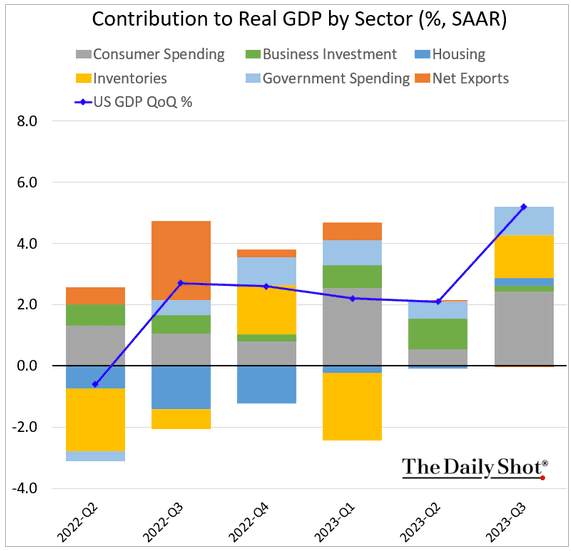BLOG. 5 min read
Forecasting the Economy is Tricky, But We Can Look at Trends
December 19, 2023 by Ken Kapner
Since the start of the COVID-19 pandemic, forecasting the economy has been a challenge, even for the experts. The disruption in the supply chain is one example of a factor causing inflation. This led to the Federal Reserve increasing interest rates at an unprecedented speed. At that time, economists forecasted the economy would end up in a recession. However, third quarter 2023 GDP was up 5.2%! Inflation has been trending down and now economists are calling for the elusive “soft landing.” Although it looks like a low probability, it is possible. What’s next? Let’s review some of the major economic variables as well as other indicators used to forecast the economy.
GDP
The increase of 5.2% in GDP in the third quarter took the markets by surprise. But the latest Federal Reserve’s beige book indicates the economy is cooling: “On balance, economic activity slowed since the previous report…”.[i]
The beige book also provides a snapshot of categorical spending contributing to the GDP (chart below).[ii] When referencing the breakdown of the contributions by sector, it’s clear the consumer has been the force behind the growth, with a boost from holiday shopping. In fact, Forbes reported that >200M shoppers visited websites and stores for the period covering Black Friday and Cyber Monday, which is an all-time high, representing participation of over 75% of adults. [iii]

Yield Curve
Another reliable indicator is the inverted yield curve. While an inverted yield curve predicts a recession, it does not predict the timing of the recession. Currently, the yield curve is still inverted and, hence, predicting a recession.
Following is the 10-Year Treasury Constant Maturity minus the 3-Month Treasury constant maturity.[iv] We see that the curve is inverted and prior inversions have led to a recession. The vertical gray bars indicate when the economy is in a recession.

Inflation
We can also use the beige book to look at inflation: “Price increases largely moderated across Districts, though prices remained elevated.” The interpretation is that the trend is down but prices are still high. The Fed’s target for inflation is 2% and using the Personal Consumption Expenditure (PCE), the Fed’s preferred inflation gauge is higher than 2%.
The following chart shows the PCE for October was 3% and excluding food and energy, it was 3.5% (not shown).[v] If we are falling into a recession, will the Fed be comfortable with inflation rates above their target of 2%?

Unemployment
What does unemployment tell us? Let’s look at a couple of sources for insight. According to the Fed’s Beige book: “Demand for labor continued to ease, as most Districts reported flat to modest increases in overall employment. However, several Districts continued to describe labor markets as tight with skilled workers in short supply.”
It appears that unemployment is a mixed bag. As shown in the following chart, non-farm payrolls have been trending down.[vi]

Another fairly new source to predict recessions is the Sahm Recession Indicator, developed by Claudia Sahm, a former Fed economist. It signals the start of a recession when the three-month moving average of the national unemployment rate (U3) rises by 0.50 percentage points or more relative to the minimum of the three-month averages from the previous 12 months (same source as below). It is currently 0.33 and trending towards the 0.50 line as shown in the following chart.[vii]

Conclusion
With so many trends to consider, it’s no wonder that forecasting the economy is tricky. For now, it seems the markets have interpreted that the Fed is done tightening and quite possibly, will be lowering interest rates. The 10-year Treasury, which just a few weeks ago was trading in the 5.00% neighborhood, is now trading below 4.00%.
The key will be to watch inflation. If there is a flare-up in inflation, the probability of the Fed lowering interest rates will most likely decrease. However, if the economy does falter and unemployment worsens, then the probability of the Fed lowering rates will increase. Combining both potential scenarios, the Fed will have to choose between a slower economy, higher unemployment and tightening monetary policy if inflation moves up. A difficult position to be in for sure!
CPE Course Library | Curious about other topics? Check out the GAMMA Library including over 300 hours of approved industry CPE courses and related timely articles. Click here to explore the full course listing, available CPE credits and registration for the GAMMA Library.
About Us | The SS&C Learning Institute is a division of SS&C dedicated to providing continuing education for today’s professionals. From a library of 250+ online CPE courses to microlearning articles and videos, our offerings are delivered by industry-leading subject matter experts and cover a wide variety of financial markets topics. To learn more about the SS&C Learning Institute, please visit ssctech.com/learn.
[i] The Beige Book November 29, 2023
[ii] The Daily Shot November 30th, 2023
[iii] https://www.forbes.com/sites/shelleykohan/2023/11/30/black-friday-and-cyber-monday-record-sales-by-the-numbers/
[iv] Federal Reserve Bank of St. Louis, 10-Year Treasury Constant Maturity Minus 3-Month Treasury Constant Maturity [T10Y3M], retrieved from FRED, Federal Reserve Bank of St. Louis; https://fred.stlouisfed.org/series/T10Y3M, November 29, 2023
[v] U.S. Bureau of Economic Analysis, Personal Consumption Expenditures: Chain-type Price Index [PCEPI], retrieved from FRED, Federal Reserve Bank of St. Louis; https://ip-10-121-51-82.ec2.internal/series/PCEPI, November 30, 2023
[vi] U.S. Bureau of Labor Statistics, All Employees, Total Nonfarm [PAYEMS], retrieved from FRED, Federal Reserve Bank of St. Louis; https://fred.stlouisfed.org/series/PAYEMS, November 29, 2023
[vii] Sahm, Claudia, Real-time Sahm Rule Recession Indicator [SAHMREALTIME], retrieved from FRED, Federal Reserve Bank of St. Louis; https://fred.stlouisfed.org/series/SAHMREALTIME, November 29, 2023
Written by Ken Kapner
SS&C Learning Institute Industry Expert





.jpg)
